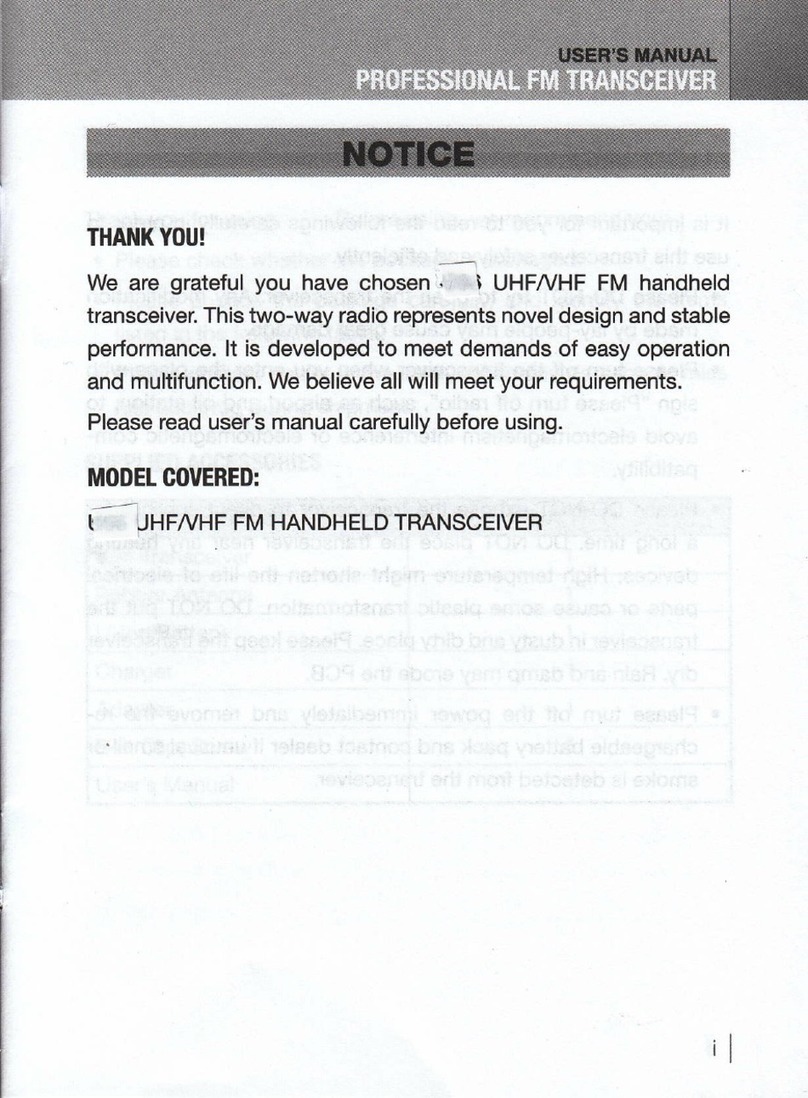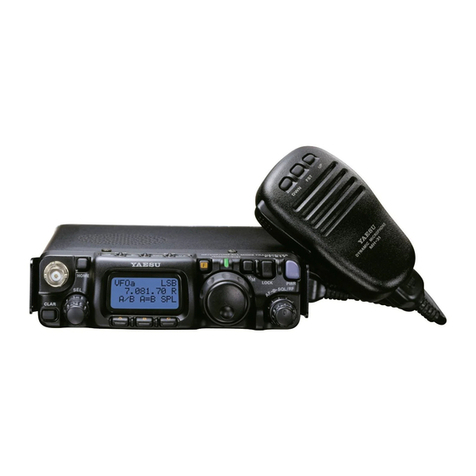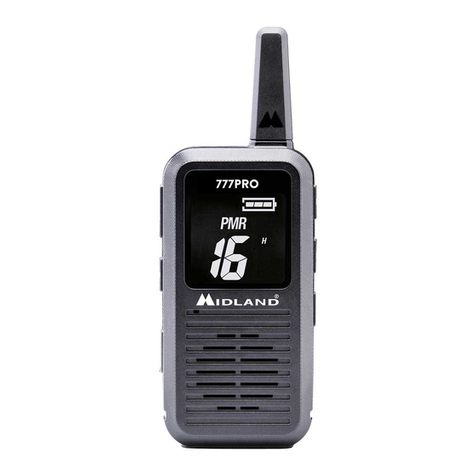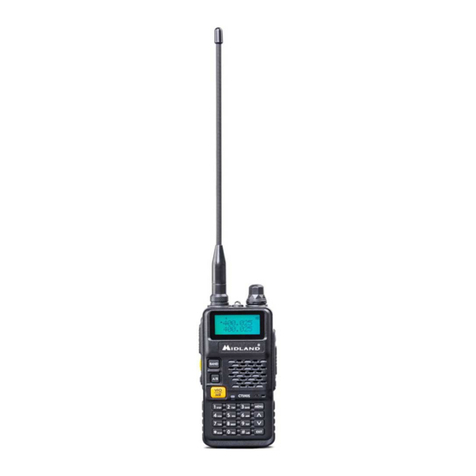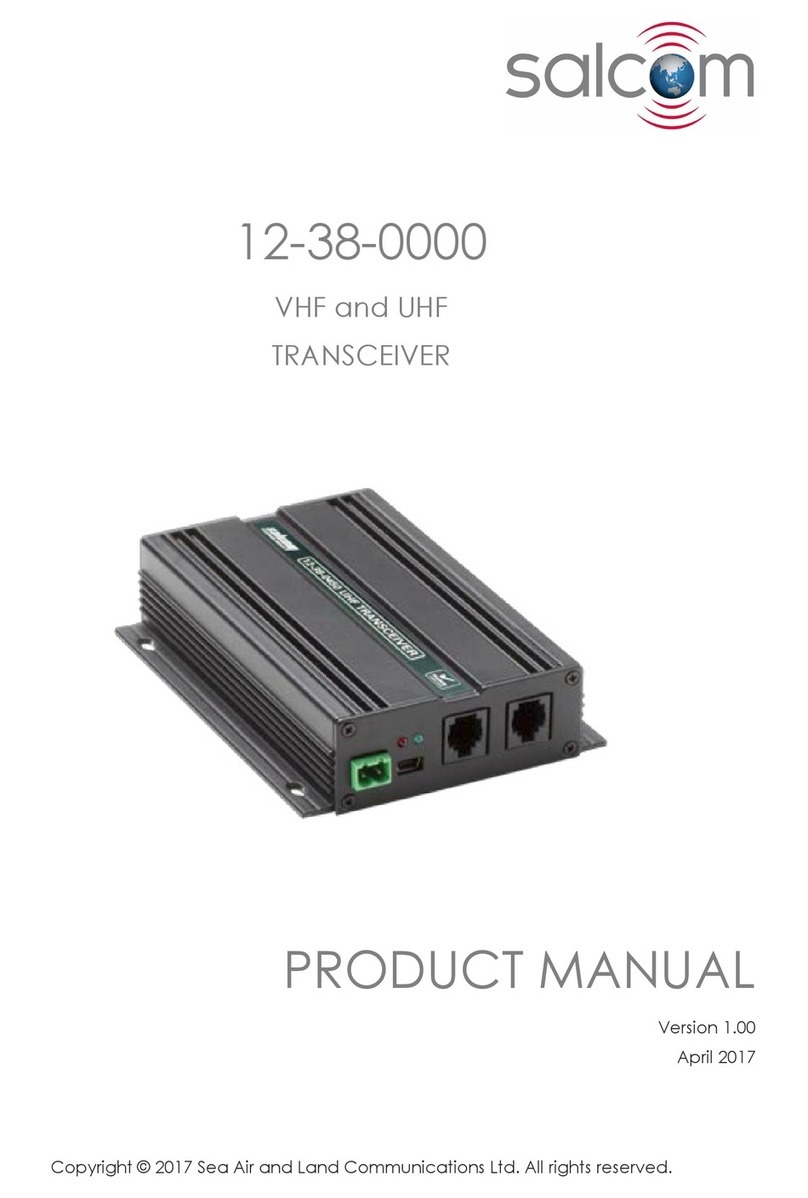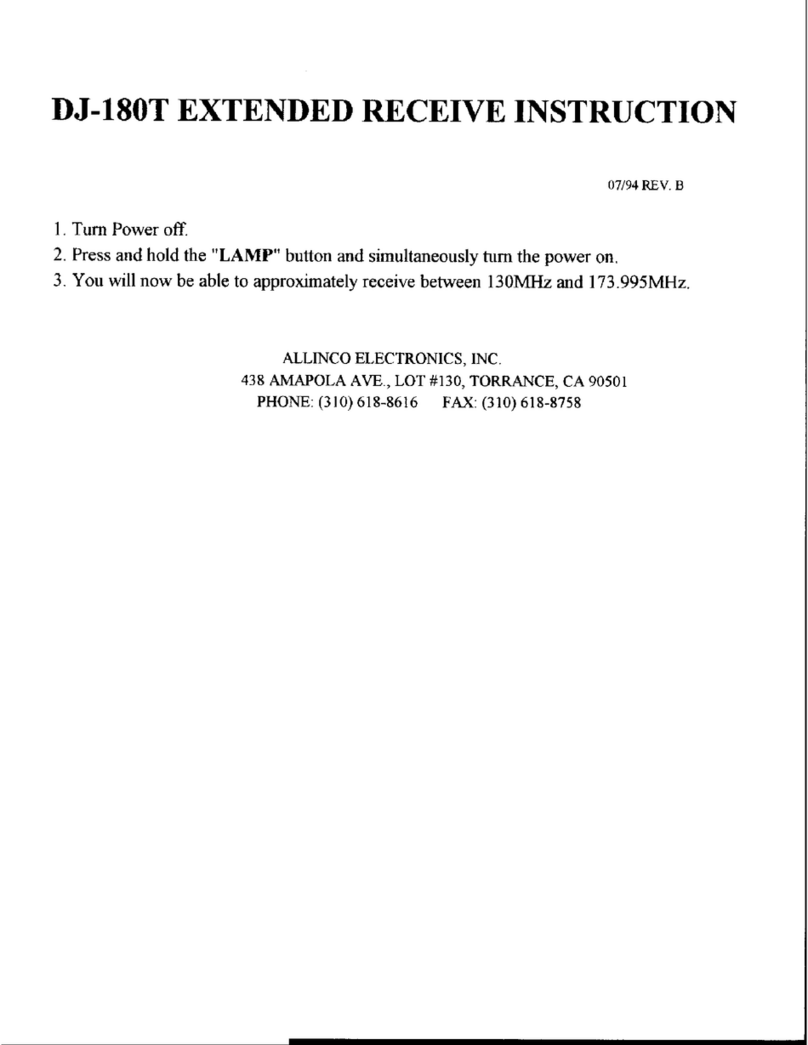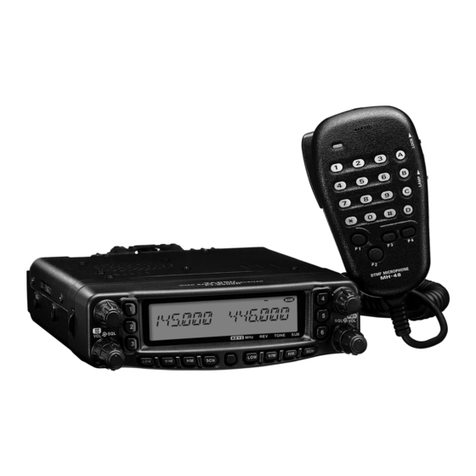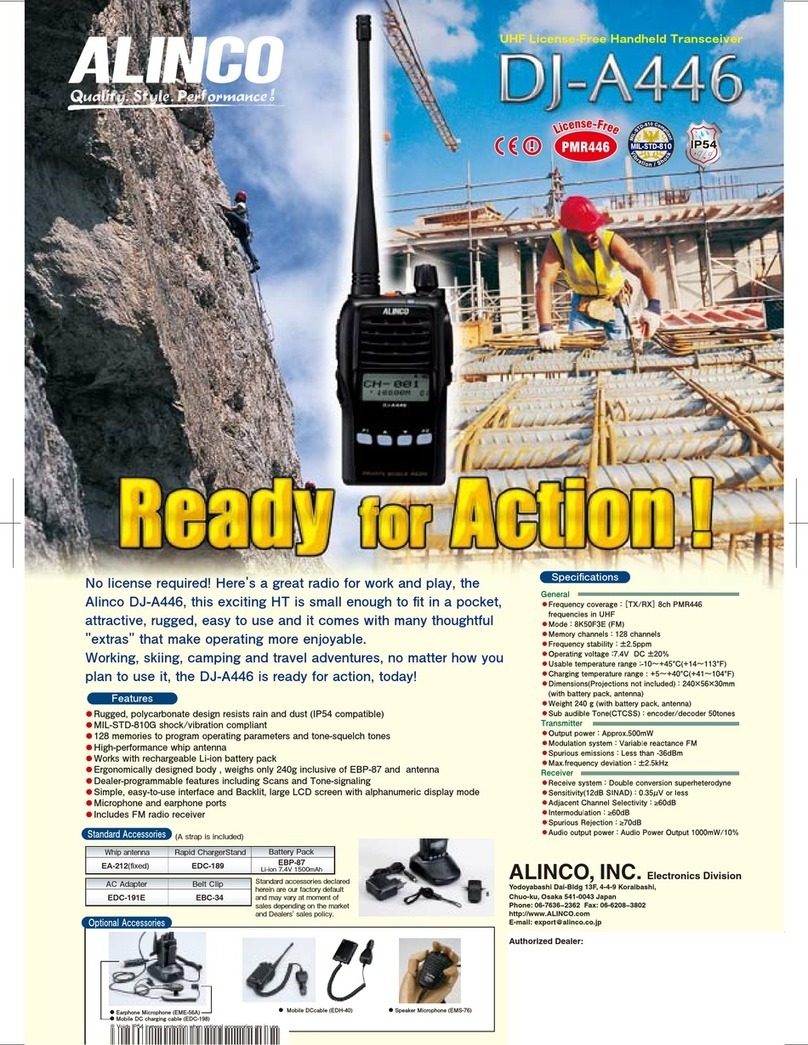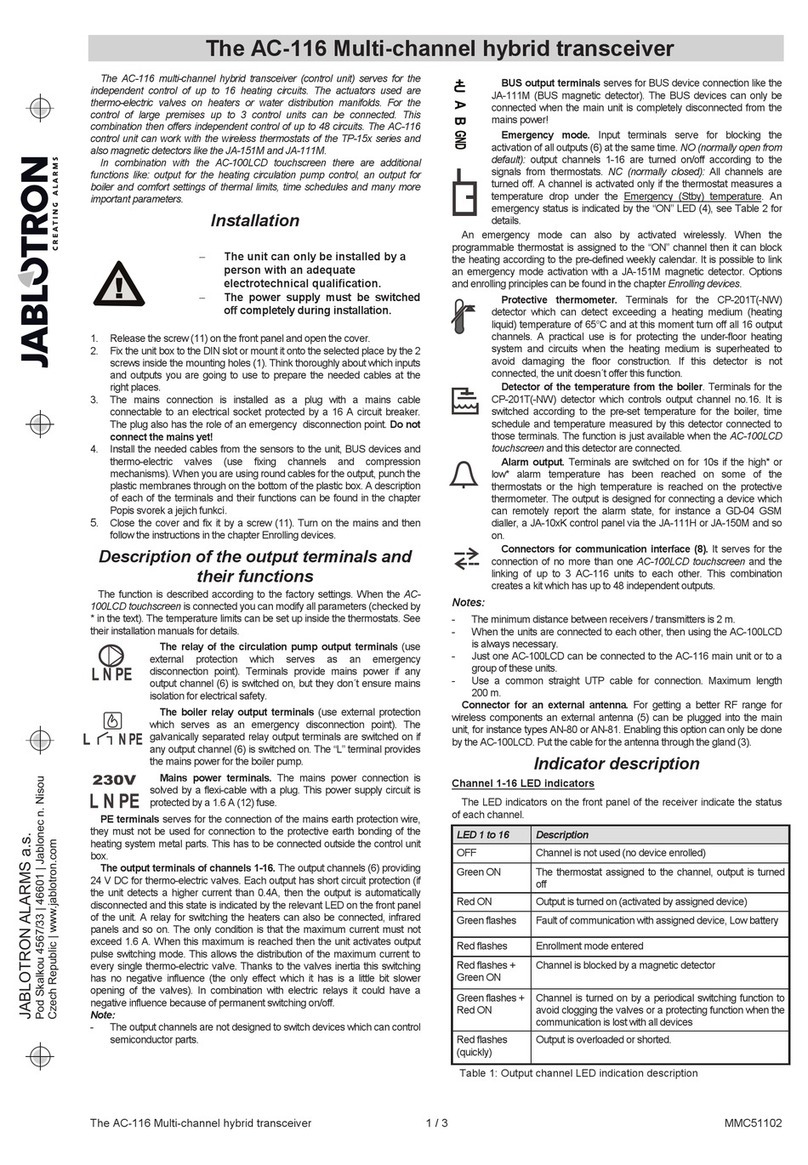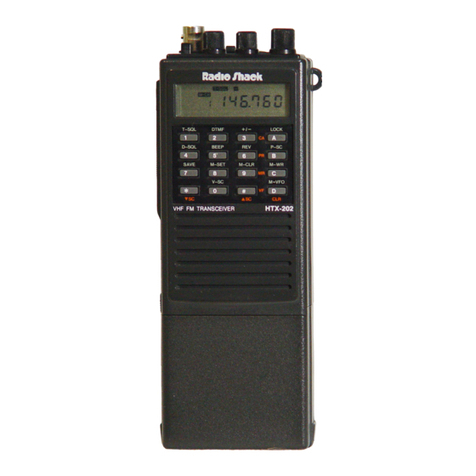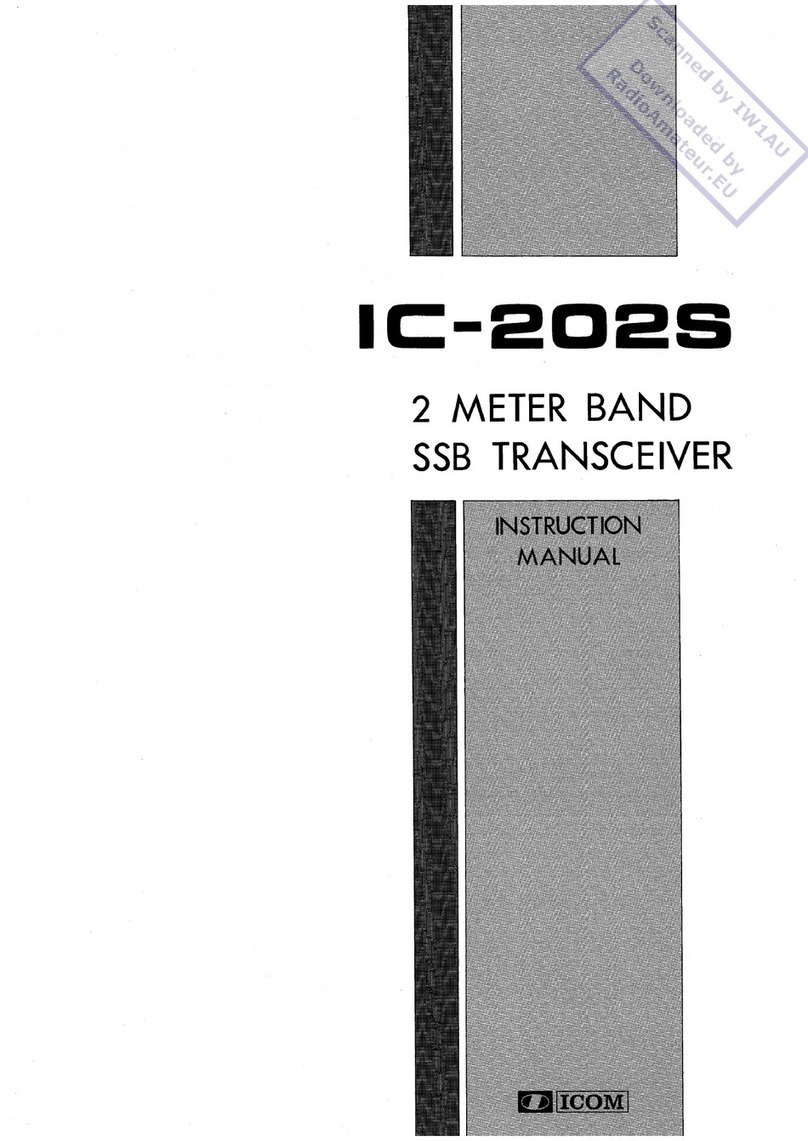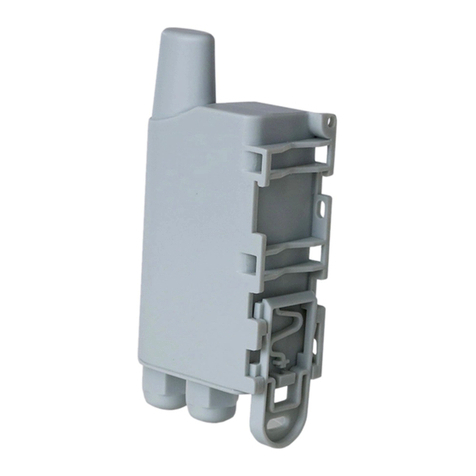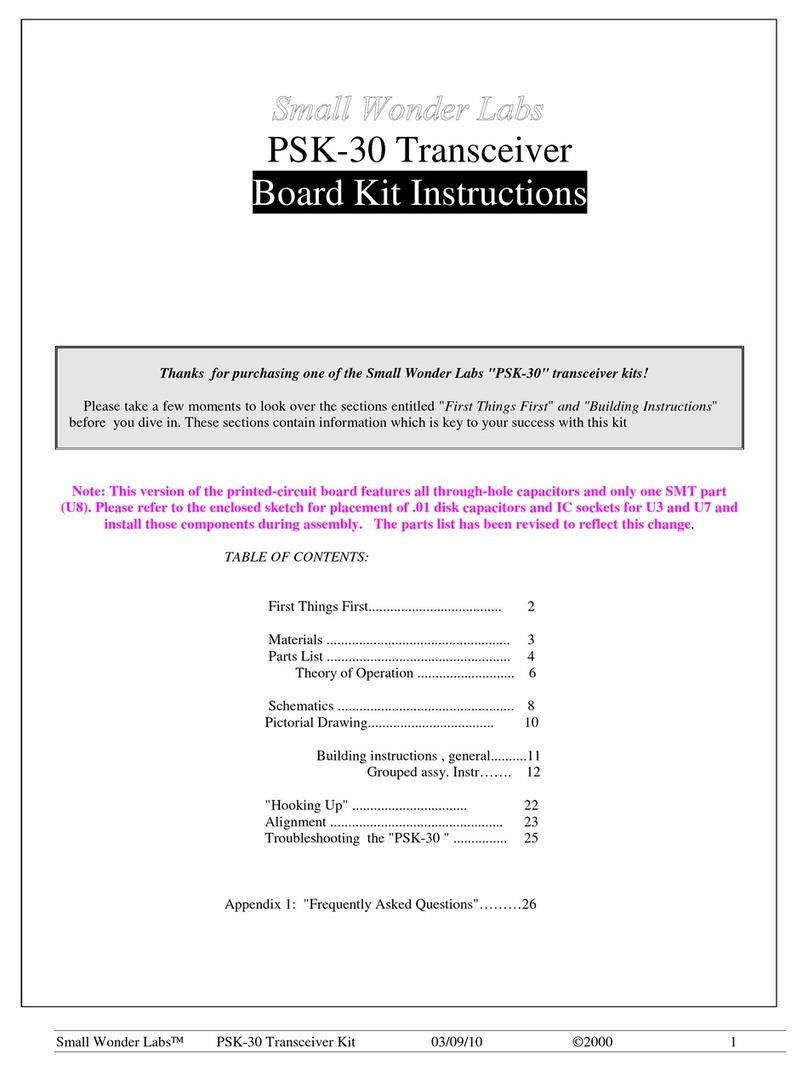Encom ENC-900 User manual

Operating Manual
Model: ENC-900
900 MHz Spread Spectrum OEM Transceiver
Revision 1.00, February 23, 2005
Encom Wireless Data Solutions Inc.
#7-640, 42nd Ave. N.E.
Calgary, Alberta T2E 7J9
Phone: (403) 230-1122
Fax: (403) 276-9575
http://www.encomwireless.com/

RF EXPOSURE
This module has been designed to comply with FCC RF exposure requirements outlined in Parts 2.1091,
2.1093, and 15.247(b)(4). Deviation from the recommended installation may violate RF exposure
requirements.
The manual for end users of the final product which incorporates the ENC-900 module must contain the
following statement in a prominent location:
To comply with FCC RF exposure requirements for mobile transmitting devices,
this transmitter should only be used or installed at locations where there is at
least 20cm separation distance between the antenna and all persons.
FCC NOTIFICATIONS
The ENC-900 module generates radio frequency energy. It must be installed according to the manufacturer’s
guidelines or it has the potential to cause interference with other radio devices. Testing has been performed to
assure that it conforms with the FCC Part 15 rules for intentional and unintentional radiators.
No further EMI compliance testing of the transmitter is required as long as the 20 cm separation and co-
location requirements are observed. Each new use of the module will, however, always need to be scanned for
unintentional radiation from digital clocks, etc.
All necessary calibration has been performed at the time of manufacture. Any modification of the device after
it leaves the factory is a violation of FCC rules.
Compliance Statement (Part 15.19)
This device complies with Part 15 of the FCC Rules and with RSS-210 of Industry Canada.
Operation is subject to the following two conditions:
1. This device may not cause harmful interference, and
2. This device must accept any interference received, including interference that may
cause undesired operation.
Warning (Part 15.21)
Changes or modifications not expressly approved by the party responsible for compliance could
void the user’s authority to operate the equipment.
RF Exposure (OET Bulletin 65)
To comply with FCC RF exposure requirements for mobile transmitting devices, this
transmitter should only be used or installed at locations where there is at least 20cm
separation distance between the antenna and all persons.

LABELING REQUIREMENTS
The FCC requires that the Part 15 statement be installed on the outside of the final product in a manner which
allows it to be seen and read. The accepted statement and a sample label format are as follows:
This device complies with Part 15 of the FCC Rules.
Operation is subject to the following two conditions:
1. This device may not cause harmful
interference, and
2. This device must accept any interference
received, including interference that may
cause undesired operation.
Contains TX FCC ID: PLQENC900
Canada: 3966A-ENC900
S/N: XXXYYYZZZ
MODEL: ENC-900
Made in Canada
The label should be printed or molded into the case using a type front and size that is readable with the unaided
eye. The FCC identification number is required.
Industry Canada Statement
The term “IC” before the certification / registration number only signifies that the Industry Canada technical
specifications were met.

900 MHz
Spread-Spectrum OEM
Radio Modem
WARNING
In order to comply with the FCC/IC
adopted RF exposure requirements, this
transmitter system will only be installed
according to manufacturer’s Installation
Guidelines. Installation of all antennas must
be performed in a manner that will provide
at least 20cm clearance from the front
radiating aperture, to any user or member
of the public.
EQUIPMENT LABELING
The manufacturer, product name, and FCC
and Industry Canada identifiers of this
product must appear on the outside label of
the end-user equipment.
This manual contains information of proprietary
interest to Encom Wireless Data Solutions Inc. It
has been supplied in confidence to purchasers an
d
users of the ENC-900, and by accepting this material
the recipient agrees that the contents will not be
copied or reproduced, in whole or in part, withou
t
prior written consent of Encom Wireless Data
Solutions Inc.
Encom Wireless Data Solutions Inc. has made every
effort to assure that this document is accurate an
d
complete. However, the company reserves the righ
t
to make changes or enhancements to the manual
and/or the product described herein at any time an
d
without notice. Furthermore, Encom Wireless Data
Solutions Inc. assumes no liability resulting from
any omissions in this document, or out of the
application or use of the device described herein.
Encom’ products are appropriate for home, office, o
r
industrial use, but are not authorized for utilization i
n
applications where failure could result in damage to
property or human injury or loss of life.
The electronic equipment described in this manual
generates, uses, and radiates radio frequency energy.
Operation of this equipment in a residential area may
cause radio interference, in which case the user, a
t
his own expense, will be required to take whateve
r
measures necessary to correct the interference.
FCC Declaration of Conformity
This device complies with Part 15 of the FCC Rules.
Operation is sub
j
ect to the followin
g
two conditions: (1) this
device ma
y
not cause harmful interference, and (2) this
device must accept an
y
interference received includin
g
interference that may cause undesired operation.
Encom Wireless Data Solutions Inc., products are warrante
d
against all failures which occur as a result of defective material
or workmanship within 24 months of purchase by the user.
This warranty does not extend to products that, in the opinion
of Encom Wireless Data Solutions Inc.., have been subject to
misuse, accidents, lightning strikes, improper installation o
r
application, nor shall it extend to units which have, in Enco
m
Wireless Data Solutions Inc.’s opinion, been opened, tampere
d
with or repaired by an unauthorized facility.
Encom Wireless Data Solutions Inc
#7-640 42nd Ave. N.E.
Calgary, Alberta T2E 7J9
Phone: (403) 230-1122Fax: (403) 276-9575
http://www.encomwireless.com/
All Rights Reserved. COMMPAK, ControlPAKare registered
trademarks of Encom Wireless Data Solutions Inc. Microsoft and Windows are
registered trademarks of Microsoft Corporation. All other products mentioned
in this document are trademarks or registered trademarks of their respective
holders.
Revision 1.00, August 27, 2004

ENC-900 Operating Manual: Chapter 1 Introduction. 1
RF EXPOSURE.............................................................................................................................................................2
FCC NOTIFICATIONS ................................................................................................................................................2
LABELING REQUIREMENTS ...................................................................................................................................3
1. Introduction ...............................................................................................................................................................3
1.0 Product Overview ................................................................................................................................................3
1.1 Features................................................................................................................................................................3
1.2 About this Manual ...............................................................................................................................................4
2. Electrical/Physical .....................................................................................................................................................6
2.0 Functional Block Diagram..................................................................................................................................6
2.1 Pin-out .................................................................................................................................................................7
2.2 Mounting Location ..............................................................................................................................................8
2.3 Antenna................................................................................................................................................................9
2.4 LED Operation ..................................................................................................................................................10
2.5 DC Characteristics.............................................................................................................................................12
3. Modes of Operation .................................................................................................................................................14
3.1 Data Mode .........................................................................................................................................................14
3.2 Command Mode ................................................................................................................................................15
3.2.1 AT Command Interface ..............................................................................................................................16
3.3 Switching Between Command and Data Modes................................................................................................16
4. Configuration...........................................................................................................................................................18
4.1 Quick Start Approach ........................................................................................................................................18
4.1.1 Checking the Link.......................................................................................................................................19
4.2 AT Commands...................................................................................................................................................19
AAnswer.....................................................................................................................................................20
ECommand Echo........................................................................................................................................20
IIdentification............................................................................................................................................20
OOn-line Mode...........................................................................................................................................20
QQuiet Mode ..............................................................................................................................................20
VResult Codes display................................................................................................................................20
WConnection Result....................................................................................................................................21
ZReset and load stored configuration.........................................................................................................21
&C DCD (Data Carrier Detect) ......................................................................................................................21
&D DTR (Data Terminal Ready)....................................................................................................................21
&F Load Factory Default Configuration........................................................................................................21
&K Handshaking ............................................................................................................................................22
&S DSR (Data Set Ready) .............................................................................................................................22
&V View Configuration .................................................................................................................................22
&E Framing Error Check ...............................................................................................................................22
&W Write Configuration to Memory ..............................................................................................................22
Sxxx? Read S register value ...............................................................................................................................22
Sxxx=yyy Set S register value..........................................................................................................................22
AT Command Result Codes ................................................................................................................................22
4.3 S Registers .........................................................................................................................................................23
S Register 0 - Auto Answer ................................................................................................................................23
S Register 2 - Escape Code................................................................................................................................23
S Register 101 - Operating Mode ........................................................................................................................24
S Register 102 - Serial Baud Rate .......................................................................................................................26
S Register 103 - Wireless Link Rate....................................................................................................................26
S Register 104 - Network Address ......................................................................................................................27
S Register 105 - Unit Address .............................................................................................................................27
S Register 106 - Primary Hopping Pattern ..........................................................................................................27
S Register 206 - Secondary Hopping Pattern ......................................................................................................27
S Register 107 - Encryption Key .........................................................................................................................29
S Register 108 - Output Power Level ..................................................................................................................29
S Register 109 - Hopping Interval .......................................................................................................................30
S Register 110 - Data Format ..............................................................................................................................31

S Register 111 - Packet Minimum Size ...............................................................................................................31
S Register 112 - Packet Maximum Size ..............................................................................................................31
S Register 116 - Packet Character Timeout.........................................................................................................31
S Register 113 - Packet Retransmissions.............................................................................................................32
S Register 114 - Sleep Mode ...............................................................................................................................32
S Register 115 - Packet Repeat Interval ..............................................................................................................33
S Register 117 - Radio Buffer Mode ...................................................................................................................33
S Register 118 - Roaming....................................................................................................................................33
S Register 119 - Quick Enter to Command .........................................................................................................34
S Register 120 - RTS/DCD Framing ...................................................................................................................34
S Register 121 - DCD Timeout............................................................................................................................34
S Register 123 - Remote RSSI Reading ..............................................................................................................35
S Register 124 - Master RSSI Reading................................................................................................................35
S Register 213 - Packet Retry Limit ....................................................................................................................35
4.4 Diagnostics, Statistics and Remote Control.......................................................................................................36
4.4.1 Spectrum Analyzer Feature (ATG).............................................................................................................36
4.4.2 Statistics (ATP)...........................................................................................................................................36
4.4.3 Remote Control and Diagnostics (S101=5) ................................................................................................37
A. Modem Command Summary..................................................................................................................................41
b. Factory Default Settings ..........................................................................................................................................43
C. Technical Specifications .........................................................................................................................................45
D. Glossary..................................................................................................................................................................47

ENC-900 Operating Manual: Chapter 1 Introduction. 3
1. INTRODUCTION
1.0 Product Overview
The ENC-900 is a high-performance embedded wireless data transceiver.
Operating in the 902 - 928 MHz ISM band, this frequency-hopping spread-
spectrum module is capable of providing reliable wireless data transfer
between almost any type of equipment which uses an asynchronous serial
interface. The small-size and superior RF performance of this module make
it ideal for many applications. Typical uses for this module include:
•SCADA
•Traffic Control
•Remote Monitoring
•Fleet Management;
•Telemetry;
•Remote Camera/Robot Control;
•Security Systems; and,
•Display Signs.
While a pair of ENC-900 modules can link two terminal devices (“point-to-
point” operation), multiple modules can be used together to create a network
of various topologies, including “point-to-multipoint” and “repeater”
operation. Multiple independent networks can operate concurrently, so it is
possible for unrelated communications to take place in the same or a nearby
area without sacrificing privacy or reliability.
1.1 Features
Key features of the ENC-900 include:
•transmission within a public, license-exempt band of the radio
spectrum1– this means that it can be used without access fees (such
as those incurred by cellular airtime);
•a serial I/O data port with handshaking and hardware flow control,
allowing the ENC-900 to interface directly to any equipment with
an asynchronous serial interface.
•64 sets of user-selectable pseudo-random hopping patterns,
intelligently designed to offer the possibility of separately operating
multiple networks while providing security, reliability and high
tolerance to interference;
•encryption key with 65536 user-selectable values to maximize
security and privacy of communications;
•built-in CRC-16 error detection and auto re-transmit to provide
100% accuracy and reliability of data;
•ease of installation and use – the ENC-900 module uses a subset of
standard AT style commands, very similar to those used by
traditional telephone line modems.
While the typical application for the ENC-900 is to provide a short- to mid-
range wireless communications link between DTEs, it can be adapted to
1902-928 MHz, which is license-free within North America; may need to be factory-configured
differently for some countries.

4ENC-900 Operating Manual: Chapter 1 Introduction
almost any situation where an asynchronous serial interface is used and data
intercommunication is required.
1.2 About this Manual
This manual has been provided as a guide and reference for installing and
using ENC-900 wireless modem modules. The manual contains instructions,
suggestions, and information which will help you set up and achieve optimal
performance from your equipment using the ENC-900 module.
It is assumed that users of the ENC-900 module have either system
integration or system design experience. Chapter 2 details the
electrical/physical attributes of the module. Chapter 3 explains the different
modes of operation, and Chapter 4 provides complete details of all
configuration parameters. The Appendices, including the Glossary of Terms,
are provided as informational references which you may find useful
throughout the use of this manual as well as during the operation of the
wireless modem.
Throughout the manual, you will encounter not only illustrations that further
elaborate on the accompanying text, but also several symbols which you
should be attentive to:
Caution or Warning: Usually advises against some action which could
result in undesired or detrimental consequences.
Point to Remember: Highlights a key feature, point, or step which is worth
noting, Keeping these in mind will make using the ENC-900 more useful or
easier to use.
Tip: An idea or suggestion is provided to improve efficiency or to make
something more useful.
With that in mind, enjoy extending the boundaries of your communications
with the ENC-900 module.

ENC-900 Operating Manual: Chapter 2 Electrical/Physical 5

6ENC-900 Operating Manual: Chapter 1 Introduction
2. ELECTRICAL/PHYSICAL
2.0 Functional Block Diagram
Transceiver
Intrgrated
Circuit
Lowpass
Filter
Bandpass
Filter
Bandpass
Filter
Power
Amplifier
T/R
Switch
Lowpass
Filter
39.00 MHz
Crystal
Microcontroller
Host
Connector
32.768 kHz
Crystal
6
10
Figure 1. Functional Block Diagram

ENC-900 Operating Manual: Chapter 2 Electrical/Physical 7
2.1 Pin-out
Figure 2 provides a top-view pin-out drawing of the ENC-900 module.
Figure 2 – Pin-out (Top View)
Table 1. Pin Description
No. Pin Name Description I/O
1 GND Ground reference for logic, radio and I/O pins.
2 VCC Positive Supply for Radio Circuitry. See
Section 2.3 for DC Characteristics
3 TXD Serial Data Input. Active low (TTL Level)
input.
I
4 RXD Serial Data Output. Active low (TTL Level)
output.
O
5 DTR RS-232 Data Terminal Ready. Active low
(TTL level) input.
I
6 CTS RS-232 Clear to Send. Active low (TTL
level) output.
O
7 RTS RS-232 Request to Send. Active low (TTL
level) output.
I
8 DSR RS-232 Data Set Ready. Active low (TTL
level) output.
O
9 RSSI1 Receive Signal Strength Indicator 1. This
output is the first of the three RSSI indicators
to become active high as the signal strength
increases.
O
10 RSSI2 Receive Signal Strength Indicator 2. This
output is the second of the three RSSI
indicators to become active high as the signal
strength increases.
O
11 RSSI3 Receive Signal Strength Indicator 3. This
output is the third RSSI indicator to become
active high as the signal strength increases.
O
12 DCD RS-232 Data Carrier Detect. Active low (TTL
level) output.
O

8ENC-900 Operating Manual: Chapter 2 Initial Setup and Configuration
2.2 Mounting Location
Mounting is accomplished via the 12 pin 0.1” header and 4 mounting
holds along the edge of the board.
In order to maintain compliance with the FCC modular certification it
is necessary to mount the module in such a way that user is never closer
than 20 cm to the antenna.
The manual for end users of the product must contain a warning about
the 20 cm separation as outlined in the beginning of this manual.
Additionally, the transceiver may not be co-located with any other
antenna or transmitter.

ENC-900 Operating Manual: Chapter 2 Electrical/Physical 9
2.3 Antennas and Cabling
This section describes the recommended procedure for installing
cabling and antennas for use with ENC-900 module.
2.3.1 Antennas
Compliance with FCC regulations may only be maintained using the
specified antennas and maximum output power cannot be exceeding 36
dBm EIRP.
See appendix A for a list of approved antennas that can be used
with the ENC-900 radio modem. All the antennas listed on the
appendix A can be purchased from Encom Wireless Data Solutions
Inc. If you require another type of antenna, please contact Encom
Wireless Data Solutions Inc. The ENC-900 cannot be used with any
antenna that does not appear in Appendix A.
2.3.2 Cabling
The most common method for installing the module is to run a short RF
Jumper cable from the module’s MCX connector to a reverse TNC
bulkhead connector on the chassis of the equipment as shown in the
following figure. These cables can be purchased from Encom Wireless
Data Solutions Inc.
RG174 Cable
with MCX male
connector
and Reverse TNC
bulkhead
connector
Reverse TNC Connector
MCX female connector
Cable losses are negligible for the short piece used within the chassis.
Additional losses up to 0.5 dB may be present in the MCX and Reverse
TNC connectors.
FCC Regulations allow up to 36dBm effective radiated power (ERP).
Therefore, the sum of the transmitted power (in dBm), the cabling loss and
the antenna gain cannot exceed 36dBm with respect to the isotropic
radiator.
ERP is calculated as follows:
ERP = Tx Power (dBm) – Cable/Connector Loss (dB) +Ant Gain (dBi)
Antenna Gain must be in dBi when calculating the 36dBm ERP limit.
1dBd = 2.15dBi

10 ENC-900 Operating Manual: Chapter 2 Initial Setup and Configuration
2.4 LED Operation
LED functionality is dependent on the mode of operation. Lines RX/SYNC,
TXMODE, and RSSI1,2 and 3 are designed to drive LED’s (active high).
Table 2 explains LED operation for the various modes.
MODE RSSI1,2,3
Power Up (S0=1) off
Power Up (S0=0) off
Command Mode off
Data Mode - Master RSSI mode based on all received packets
See Table 3
Data Mode - Repeater
During Sync.
Acquisition
alternating 300ms ON
Data Mode - Repeater
When Synchronized
RSSI mode based on packets received from
Remotes*
See Table 3
Data Mode - Remote
During Sync.
Acquisition
alternating 300ms ON
Data Mode - Remote
When Synchronized
RSSI mode based on packets received from the
Repeater or Master with which it
communicates
See Table 3
*If Remote have been silent for 2 seconds, repeater will base its RSSI on
packets received from the Master.
Table 2. LED Operation

ENC-900 Operating Manual: Chapter 2 Electrical/Physical 11
Signal strength, which is also reported in Register S123, is calculated based
on the last four valid received packets with correct CRC, and represented by
RSSI1, 2 and 3.
For Remotes, packets are received on every single hop either from a repeater,
or the master.
When calculating RSSI, the master takes into consideration all packets
received from Remotes and repeaters. Repeaters and Remotes only transmit
back to the master when they have information to send. Therefore, if no data
is coming back to the master then RSSI will never get updated at the master,
and the LED’s will be off.
Signal Strength
(dBm)
RSSI1 RSSI2 RSSI3
-95 50% duty cycle off off
-90 on solid off off
-85 on solid 50% duty cycle off
-80 on solid on solid off
-75 on solid on solid 50% duty cycle
-70 on solid on solid on solid
Table 3 - RSSI mode operation

12 ENC-900 Operating Manual: Chapter 2 Initial Setup and Configuration
IMPORTANT:
For best performance, it is
strongly recommended to use
a separate, linearly regulated
supply for Vcc Radio. Do
not directly feed a switching
power supply into Vcc
Radio.
Caution: Using any other power
supply which does not provide the
proper voltage or current could
damage the ENC-900 module.
2.5 DC Characteristics
Characteristic Min Typ Max Units
Supply Voltage 3.80 V
Transmit Current at 1W 900 mA
Receive Current 28 mA
Sleep Current 1 mA

ENC-900 Operating Manual: Chapter 2 Electrical/Physical 13

14 ENC-900 Operating Manual: Chapter 3 Configuration Options
3. MODES OF OPERATION
Refer to Appendix A for a
summary of the modem
commands
Configuration options are not
stored in non-volatile
memory until the WRITE
command (&W) is executed
The ENC-900 modem can be easily configured to meet a wide range of
needs and applications. The module is designed such that all communication
is through one serial port. This port has two functions:
It provides the asynchronous interface with the host equipment for data that
is sent/received on the RF channel. When operating in this fashion, the
module is said to be in data mode.
It is also used for configuring and programming the module. When
operating in this fashion, the module is said to be in command mode.
In addition to data mode and command mode, there is a third mode of
operation called diagnostics mode. The module will always be in one of
these three modes.
3.1 Data Mode
Data mode is the normal operating mode of the ENC-900. When in data
mode, the ENC-900 is communicating with other ENC-900 modules, and
facilitating wireless asynchronous serial communication amongst two or
more terminal devices. There are three basic elements to any ENC-900
communications network:
•One module configured as the Master
•Zero or more modules configured as Repeaters
•One or more modules configured as Remotes
The function of the Master is to provide synchronization for the entire
network, and to control the flow of data. There is always one Master per
network. The Master is the ultimate destination for all data collected at the
various Repeater’s and Remote’s serial ports. With the network set up for
Point-to-Multipoint communication, all data received at the Master’s serial
port is transmitted to every Repeater and Remote in the network. The ENC-
900 is a frequency hopping transceiver, meaning that it “hops” to a new
frequency after a predetermined time interval. This time interval is a fixed
time set by the user, and can range from 8ms to 200ms. The ENC-900 hops
according to a pseudorandom pattern of 50 different channels.
When configured as a Remote, the ENC-900 searches for synchronization
with a Master. Network topologies consisting of a single Master and
virtually any combination of Remotes and Repeaters may be deployed. The
functionality of any particular ENC-900 can be configured as follows:

ENC-900 Operating Manual: Chapter 3 Configuration Options 15
MS
Network 1
MSR
MSR
Network 2
M
S
S
S
Network 3
MR
S
S
S
Network 4
MR
SR
S
Network 5
Figure 4 - Sample Network
Topologies. Virtually any
Combination of Remotes and
Repeaters May be Used.
Master Point-to-Point: The modem is configured to communicate
with a single Remote, either directly, or through one or more
Repeaters.
Master Point-to-Multipoint: The modem is configured to
communicate with one or more Remotes and/or Repeaters.
Remote: The modem is configured to communicate with one
Master either directly or through one or more Repeaters..
Repeater: The modem is configured to pass information from
either a Master or another Repeater onto subsequent Repeaters
and/or Remotes and vice versa. The Repeater also acts as a Remote
in the sense that, like a Remote, it passes information to/from its
serial port.
Examples of different network topologies are shown in Figure 4. Network 1
shows Point-to-Point communication between a Master and Remote.
Network 2 makes use of a Repeater to communicate with the Remote.
Network 3 illustrates a simple Point-to-Multipoint network with no
Repeaters. Networks 4 and 5 gives examples of Point-to-Multipoint
networks consisting of both Repeaters and Remotes. There is effectively no
restriction to the number of Repeaters and Remotes that can be added to a
network. As seen in Network 4, a Master can communicate directly with
both Remotes and Repeaters.
3.2 Command Mode
The ENC-900 firmware has been designed to allow the user to customize the
operation of the modem through an AT Command Interface. This interface
is ideal for direct interface with another microcontroller or for higher level
Windows-based software applications, but also contains user-friendly built-in
register descriptions. These descriptions make it easy for the user to
configure the unit by manually inputting AT Commands and modifying S-
Register parameters, using any standard terminal program. The ENC-series
development board is a useful tool for familiarizing yourself with the various
operating parameters and user interface. Reference schematics for the
development board can be found in the development kit user’s manual. To
access the ENC-900’s command mode using the development board:
1. Insert the module into the socket with the antenna connector at the
end near the power jack.
2. Attach the supplied antenna.
3. Connect a straight through serial cable between the DB9 connector
and the serial port on your PC
4. Run any terminal application program such as Hyperterminal
5. Set the serial port to 9600 baud, 8N1
6. Apply power to the development board
7. While the three RSSI LED’s are blinking, type ‘ENC’ (you have
about 5 seconds to do this). The modem should respond with ‘OK’.
8. Type ‘AT&V <ENTER>’

16 ENC-900 Operating Manual: Chapter 3 Configuration Options
3.2.1 AT Command Interface
At this point you should see a menu similar to the following appear:
BAUD = 9600
E1 Q0 V1 W0
DCD &C1 DTR &D0 Framing &E0 Handshaking &K3 DSR &S1
S0=1 S2=43 S3=13 S4=10 S5=8
Operating Mode S101=1 Serial Baud Rate S102=7
Wireless Link Rate S103=2 Network Address S104=1
Unit Address S105=1 Hop Pattern S106=0
Encryption Key S107=1 Output Power S108=2
Hop Interval S109=4 Data Format S110=1
Packet Min Size S111=1 Packet Max Size S112=43
Packet Retransmissions S113=1 Quick enter to command S119=1
Packet Repeat Interval S115=1 Character Timeout, ms S116=8
RTS/DCD Framing, ms S120=0 DCD Timeout, ms S121=0
Secondary Hop Pattern S206=2 Packet Retry Limit S213=2
Average RSSI value S123= -0 dBm Buffer Mode S117=0
Roaming S118=0 Packet Size Control S114=0
Remote Control S122=0
OK
The ENC-900 is controlled through an AT Command line interface using a
command set which is very similar to a traditional Hayes telephone modem
command set.
All line entries must be preceded by the characters ‘AT’. The characters
‘AT’ are known as the attention characters and must be typed at the
beginning of each command line. For example, to change the operating
mode, type:
ATS101=2 <ENTER>
The modem should respond with ’OK.’ The above command will set the
operating mode to Master Point-to-Point.
Register settings are not immediately stored to non-volatile memory,
therefore if the modem is powered down at this point, the Operating Mode
would revert to its previous value. To store any recently updated command
registers, the following “write” command must be entered.
AT&W <ENTER>
3.3 Switching Between Command and Data Modes
Your modem must be in command mode for it to execute a command. If you
send characters when the modem is in data mode, the modem transmits the
characters over the air.
Depending on its settings, the modem will either power up in command
mode or data mode. Normally, when first received from the factory, the unit
will power up into data mode. During the first five seconds after power-up,
the user is given the opportunity to avoid entering into data mode but instead
enter into command mode by typing ‘enc’.
Table of contents

